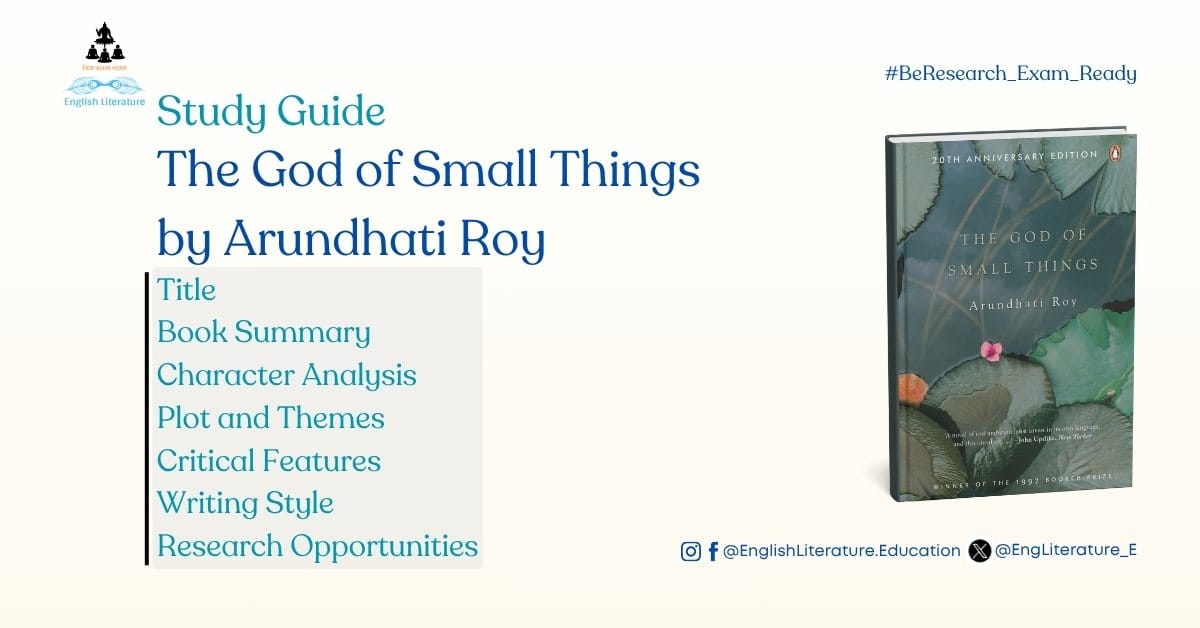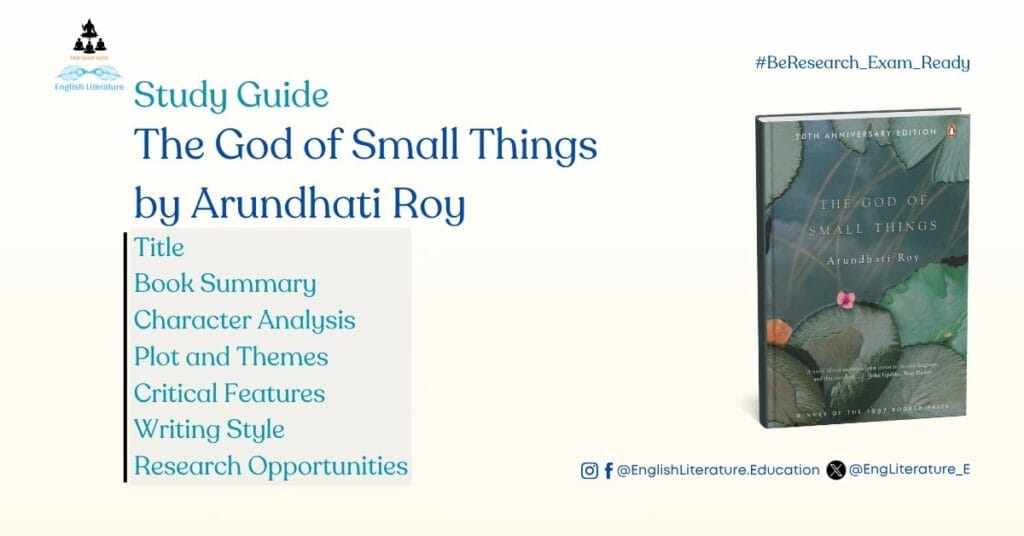Question:
How does Arundhati Roy’s use of a non-linear, fragmented narrative structure in The God of Small Things reflect the fractured psychological and socio-political realities of postcolonial India?
Arundhati Roy’s The God of Small Things is a landmark in postcolonial Indian fiction, offering a richly layered narrative that resists conventional storytelling in both structure and style. The novel unfolds in fractured time, shifting across decades, perspectives, and emotional registers. This fragmentation is not merely stylistic—Roy deploys it as a deliberate political and philosophical strategy. Through disrupted chronology, elliptical transitions, and affective language, the novel captures PTSD-like trauma, historical disinheritance, and ideological collapse. The result is a text that does more than tell a family tragedy; it invades accepted narratives, unsettles national memory, and articulates the psychic and social fractures left by colonialism, caste, and power.
From its initial lines, the narrative structure signals disorientation: “They all broke the rules. They all crossed into forbidden territory. They all tampered with the laws. They all tampered with the laws that lay down who should be loved, and how. And how much.” (Roy 3). These repeated clauses cascade through the prologue, establishing rhythm and rupture rather than sequence. The effect mimics the twins’ inner fragmentation—Estha’s silences, Rahel’s vertiginous memories—in an India where past horrors reverberate painfully in the present. The narrative’s sudden leaps, such as skipping from Ammu’s death to Estha’s stunted speech, or from Sophie Mol’s drowning to Baby Kochamma’s obsessive consumption of Western television, emulate trauma: it never progresses smoothly but jags forward, recoils, returns, and circles.
The deliberate refusal to adhere to linearity reflects the emotional logic of memory. Cathy Caruth suggests that trauma “is never simply assimilated, mastered, by being fully known. Trauma is always a response to an overwhelming event or events that could not be fully understood at the time” (Caruth 4). Roy performs this reality: traumatic moments surface unexpectedly and remain unprocessed. Estha’s brokenness appears in mid-sentence decades later; Rahel’s reflections oscillate between innocence and numb calculation. The structure itself embodies what Ashis Nandy terms the psychic residue of colonialism—an inner dissociation that escapes the grand narratives of national progress (“Remembered Village” 45). Postcolonial India must confront these half-erased histories. Roy places those erasures in full view, refusing to order them.
Linguistic fragmentation complements emotional and structural disruptive strategies. Roy’s English is intercut with Malayalam words, capitalised mid-sentence (“History House”), whimsical phonetics (“Orangedrink Lemondrink man”), and deliberate neologisms (“Love Laws”). Such hybridity echoes Homi Bhabha’s concept of cultural interstice: a space where colonised subjects disrupt dominant norms through mimicry and displacement (Location of Culture 118). The language itself becomes a site of rupture. The text performs colonised speech, but inhabits it with local textures and rhythms. In doing so, it enacts a politically resistant stance: refusing to assimilate into colonial English or to remain subalternly silent.
Yet the fragmentation is not merely a stylistic gimmick; it reflects socio-political disillusionment. The novel’s treatment of the state, religion, and political left exists in fractured modes of rule. Consider the pathos surrounding the betrayal of Velutha, denied by the Communist Party he serves, he is destroyed by an ideological betrayal that resonates as farce and tragedy. Priyamvada Gopal notes that Leftist hypocrisies punctuate the God of Small Things: the CPI(M) promises revolution but enforces patriarchal and caste hegemony (Gopal 212). Instead of progressive solidarity, party functionaries like Comrade Pillai answer Velutha’s plea by invoking private morality: “the Party was not constituted to support workers’ indiscipline in their private life” (Roy 196). This narrative rupture dissects institutional doublespeak and underscores the Indian Left’s failure to uproot caste subjugation. And the narrative form amplifies this betrayal—Velutha’s death is told in small interludes, minute glimpses rather than heroic defiance—thus refusing to mythologise his martyrdom, even as it illustrates the limits of revolutionary rhetoric.
Spatially, Roy fractures time and place. Ayemenem of 1969—a place of mango groves, Parthas, and caste consciousness—collides with Ayemenem of 1993—a tourist town populated by “lolling” Westerners and hospitalised tourists (Roy 197). The river that sustains quotidian life becomes the repository of Sophie Mol’s body. The Paradise Pickles factory, once productive, now groans under decay. Time and memory intertwine: the decayed domestic sphere mirrors civic entropy. The broken factory becomes a monument to postcolonial decline, a symbol of lost epochs and shattered futures.
This spatial and temporal disorientation counters nationalist teleology. By shattering moment-to-moment realism, Roy rejects a march toward modernity. Instead, the novel suggests that postcolonial identity is built on scatterings of the personal. It refuses triumphant realism. Much as in Salman Rushdie’s Midnight’s Children, Roy resists the one-story nation. Yet, unlike Rushdie’s exuberant magical realism, Roy’s narrative is sober and elegiac, attuned to the sorrows of women, lower castes, and children.
Moreover, the children-centric perspective is itself a structural intervention. The world is seen through the shaky vision of children: partial understandings, misheard conversations, fearful reversals. Roy privileges their consciousness, not innocence, but precarity. The novel’s elliptical structure serves to preserve their vulnerability while staging ideological critique. Childhood becomes a method: the narrative resists closure, as children cannot impose a sense of order on their lives. Their world is permeable, adorned with political edicts, caste insults, and private conspiracies that intrude upon it. By structuring the text amid their view—fragmented and unstable—Roy invites us to feel the epistemic vertigo of living at the intersections of domestic cruelty, caste brutality, and patriarchal authoritarianism.
The novel’s form becomes ethics. Each narrative fracture, ellipsis, or sudden shift asks the reader to participate. The unauthorised pause makes you search, re-evaluate, and re-feel. By creating a text that simulates dislocation, Roy reshapes reading into ethical engagement. We become vulnerable to the story’s rhythm. The tragic conclusion with two children scarred, a woman dead, a man destroyed, comes less as a plot resolution than as a wrenching emotional consequence, multiplied by fragmented storytelling.
Initially, it may appear that Roy’s style and fragmented narrative might alienate readers by disrupting their flow and connection with the story’s growth and development, as well as its characters. And it indeed might be the case because the beginning of the novel rides on the fictional liberty subduing the basics – the whens and wheres of the story. However, the abrupt storytelling and a fractured narrative laden with disorientation and ambivalence in the characters perfectly suit the post-textual criticism we often employ to fulfil our academic compulsions and meet the perceived expectations by dissecting the text (at any cost). Though it may be impossible to affirm whether Arundhati Roy deliberately kept that hiatus in her script or it was bound to be because of her limitations, the absence of a pre-existing bridge between ordinary readers and the text opened the door for intellectual engineers who play with words to build the bridges of their own and bring out all the possible post-colonial peripherals to go along the text!
Ultimately, Roy uses rupture to expose power structures embedded in time. The narrative becomes a moral matrix wherein the weight of small acts explodes into historical violence. Personal acts—Ammu’s kiss, Baby Kochamma’s TV obsession, Chacko’s Anglo-flirtations—link to caste, class, and postcolonial corruption. The fractured structure places the personal and political in dialogue, refusing top-down explanations. Instead, we learn that postcolonial India is less a united nationhood than a contested space of fragmentary belonging.
In conclusion, Roy’s deliberate fragmentation mirrors the fractured nature of both selves and societies. The non-linear structure refuses nationalist mythologies and patriarchal order, foregrounding trauma, ideological betrayals, and contested memories. Language itself becomes a site of rupture and reclamation—the novel stages its critique in form as much as in content. The God of Small Things demands an unstable reading, not a comforting one, but a transformative one. In a nation haunted by unacknowledged divides, Roy’s ellipses call us to slow down, to notice, to bear witness, one fragment at a time.
Suggested Secondary Reading:
Caruth, Cathy. Unclaimed Experience: Trauma, Narrative, and History. Johns Hopkins UP
Gopal, Priyamvada. The Indian English Novel: Nation, History, and Narration. Oxford UP
Nandy, Ashis. Intimate Enemy: Loss and Recovery of Self Under Colonialism, Oxford UP
Want to explore more about The God of Small Things? Go to The God of Small Things Study Guide.
Alok Mishra for the English Literature Education platform


